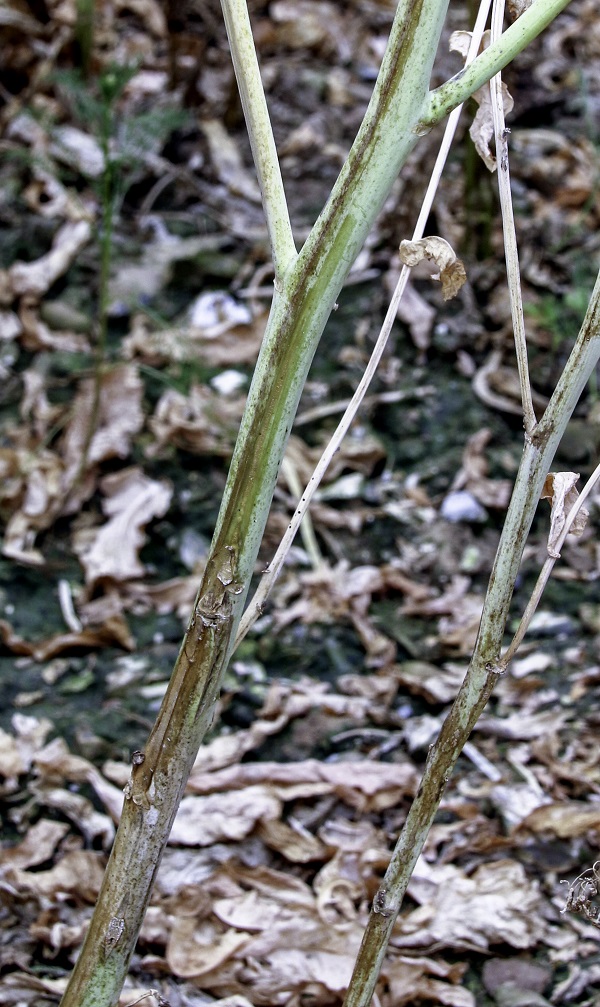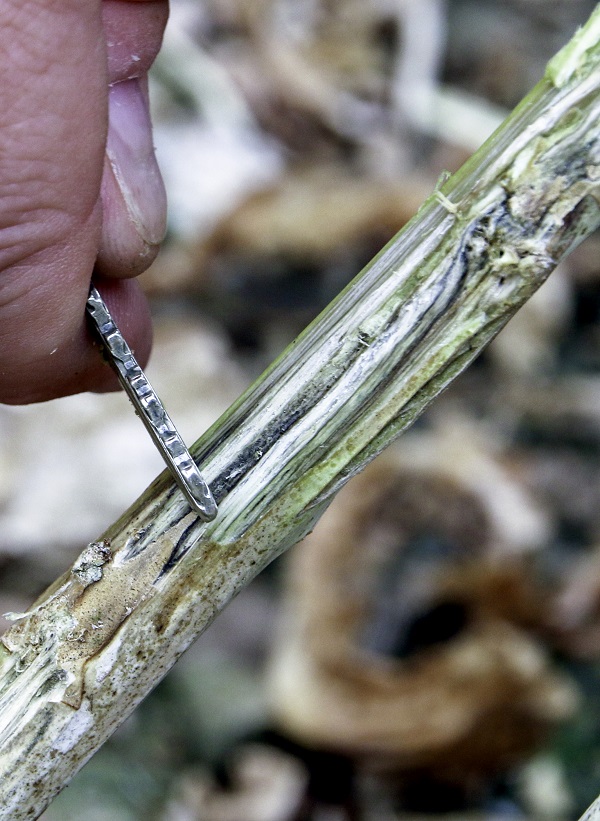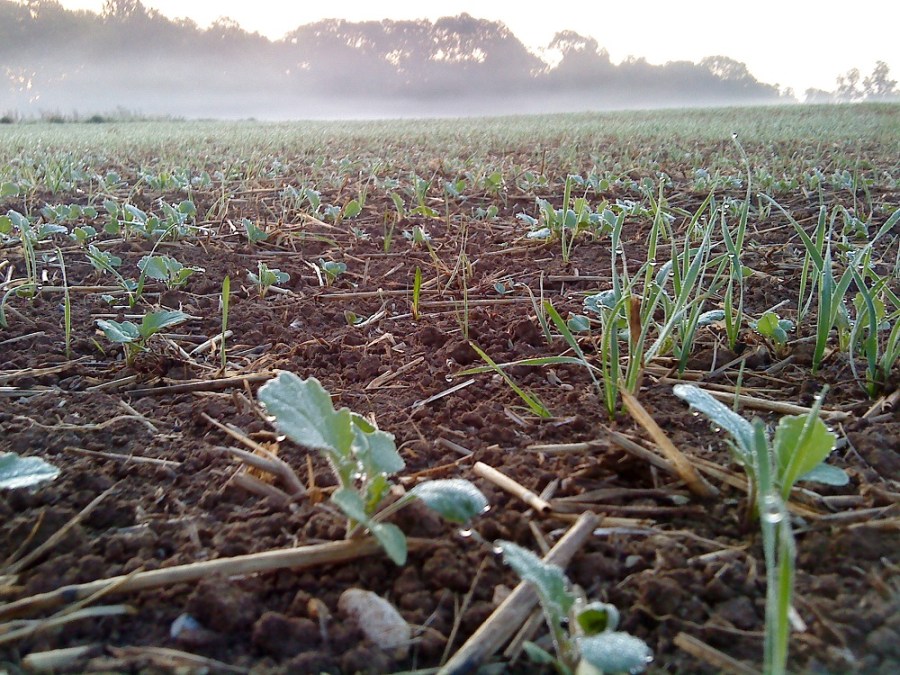The impact of verticillium wilt is believed to be becoming progressively worse in the UK. Symptoms are often not visible until late in the season, but damage can start in the autumn when establishment is key. CPM investigates.
Severe infections have been found to cause stunting and chlorosis of infected seedlings.
By Rob Jones and Lucy de la Pasture
Oilseed rape is a crop well known for its variable performance from year to year. While some of the factors which affect it are easily identified, others are more insidious and weaken plants, making the crop less resilient to other problems. Verticillium wilt is just one of these.
It’s reckoned to hit yields by up to 25%, although in extreme instances where the canopy collapses and seed shedding occurs, losses have been far higher. Perhaps most worryingly, verticillium wilt is a problem with no easy solutions and one that’s getting worse in the UK.

Despite the apparent threat, little is known about the disease including how it arrived in the UK or what level of inoculum is needed to cause yield loss, says Tim Boor, research consultant at ADAS.
He believes environmental factors such as soil type, soil temperature, and soil moisture influence disease incidence, but to what extent is not fully understood.
“We’re seeing greater severity of infection and an expansion in the area affected,” says Tim. “Verticillium wilt is a relatively new disease in the UK, and this is part of the problem facing researchers in developing our understanding of it and its impact.
“This means we haven’t been in the game that long. We simply don’t have the decades of research that we have with other diseases such as light leaf spot,” he adds.
Another of the big challenges with verticillium wilt is how the disease manifests towards the end of the growing season.
“Assessing its incidence and consequential impact is complicated because it’s often difficult to diagnose in the field until seeds start to ripen. Early symptoms may appear at flowering and, at this time, affected OSR plants show chlorosis of branches and leaves. Despite its name, distinctive wilting symptoms are rarely seen,” he adds.
Its occurrence can also be masked by other diseases, particularly phoma stem canker, explains Tim.
“Verticillium wilt symptoms can be distinguished from other diseases as it causes vertical yellow or brown stripes extending up one side of the stem and into the branches. This occurs while stems are still green and gradually darkens before surface layers decay or split to reveal the underlying grey microsclerotia,” he says.
The extent of the lesion can be explored by scraping away the surface of the affected band from soil level to the upper branches, he explains. “This exposes the grey discolouration where the pathogen is present in the vascular tissue. Often only a small proportion of the stem circumference is affected so the vertical band and number of small branches affected is quite small. In some plants however, the whole circumference is affected and the whole plant ripens prematurely or dies.”
Verticillium wilt was officially confirmed in England in 2007 (on farms in Kent and Herefords), but general reports since suggest it’s now widespread across the southern, eastern and central regions of England. It’s thought to be less endemic in the north of the UK. But while the UK situation is typically less severe than that seen in some European countries, we shouldn’t be complacent, believes Tim.
“The area of crop severely affected with verticillium wilt may not be on a par with that in some other countries, but it’s worth noting that there are no chemical solutions to this problem. That means other strategies need to be relied on to prevent the disease from being worse.

Scraping back the surface of the stem reveals the pathogen in the vascular tissue.
“These include using long rotations, with at least four years between brassica crops, and selecting appropriate varieties,” he says.
Outside the UK, the causal pathogen Verticillium longosporum has been widely reported in Germany, Poland, Ukraine and southern Russia, but it is perhaps the experience of Sweden that is most valuable to the UK.
“Sweden is still coping with the legacy of the short OSR rotations that were common in the 1950s. It was recognised as the most important disease of OSR in Sweden in 1960 and even today, yield losses as a result of verticillium wilt are generally cited as being up to 50%,” says Tim.
He also highlights another potentially valuable lesson for UK growers, referring to German studies which considered the role of cultivation strategy and length of growing season in supporting disease incidence.
“Conservation tillage gave slightly more verticillium wilt than ploughing, while extending the growing season from a standard 45 weeks (315 days) to 46-48 weeks increased substantially both disease incidence and micro-sclerotial populations in soil,” he comments.
The extended season was achieved mostly by earlier sowing. “Whether delayed sowing can reduce the risk of severe autumn infection under UK conditions has not been tested. When it comes to sowing date, a balance must be drawn to ensure that oilseed rape plants are still well established,” he adds.
While most infestations are thought to be the result of soil-borne inoculum – it’s generally accepted that microsclerotia can survive in the soil for long periods, probably more than 10 years – transmission via seed is also a distinct possibility.
“Because of this possibility, it’d be prudent to avoid the use of home-saved seed from affected crops,” says Tim.
So what about variety choice as a means of reducing the risk of yield losses from verticillium wilt?
The impact of the disease has been troubling breeders for more than a decade. This is partly because resistance mechanisms are poorly understood, but also breeders are having to look to other brassica species for resistance, explains Carl Gibbard, KWS oilseed rape breeder.
KWS is one breeder which suffered an unfortunate lesson with the disease. Its variety Quartz came to market in 2010 and quickly caught the attention of growers only to suffer a premature end after being found to be highly susceptible to verticillium wilt.
“Verticillium wilt simply wasn’t a disease we considered during our variety screening and UK assessment process at the time,” he explains.
“Our focus has always been on selecting varieties that are well suited to the UK, but we were slow to recognise the importance of verticillium wilt and the incidence of disease on farms as a consequence of short rotations or early August drilling. Quartz was a harsh lesson and, as a result we are now ahead of the pack and have been screening all UK and continental material for tolerance since 2012,” he explains.
“We’ve dropped promising varieties purely because of poor tolerance to verticillium wilt. In Barbados and Campus, we have varieties that have demonstrated excellent tolerance across several seasons, while Flamingo is the new benchmark standard,” he adds.
Using a pot test developed by Peter Gladders during his time at ADAS Boxworth, varieties are inoculated and the impact on vigour measured against uninoculated plants once the plant reaches four true leaves.
“Severe infections have been found to cause stunting and chlorosis of infected seedlings with death occurring within a month, so verticillium wilt can be highly damaging in the autumn. With ADAS’ assistance Catana was identified as having the best resistance of all varieties available at the time. With that in mind, our aim since is to have tolerance as good as or better than Catana,” says Carl.
A route to better OSR establishment
Companion plants in OSR are helping one South Yorks grower boost the crop’s establishment, providing valuable insurance with reduced cultivations and on heavier soils.
Good soil structure is vital to help OSR make the best start, says Robert Atkinson, who grows 40ha of the crop at Adwick Grange, Woodland, near Doncaster. He’s moving to a low-till/direct drilling regime across the farm, mainly to help control blackgrass, which he admits requires something of a leap of faith with a small-seeded crop, like OSR sown at low rates.
Wet, compacted soils can also be a problem on his heavier land. “OSR needs to get its roots down quickly, and anything that compromises that must be avoided,” he says.
To help optimise establishment and root growth, Robert now grows berseem clover alongside most of his OSR area. It’s strong rooting action can also allow a light cultivation to be omitted on the better land, says Robert.
He started companion cropping four years ago with a half-field trial for Agrovista. “I didn’t actually notice much of an improvement, so I was a bit sceptical. But Chris Martin (Agrovista technical manager) persuaded me give it another try.”
Robert chose a wetter field, with a red clay subsoil. “This time, we could see to a line where we had been using the berseem clover – it was like chalk and cheese.
“Since then, I have used it widely each season. It can certainly cope with minor compaction, giving me more confidence where I am reducing cultivations and on heavier soils, where it allows a bit more leeway on how you set your machines.”
Better-land OSR crops are usually direct-drilled with a three-year old 3m Moore disc drill, bought primarily to sow spring cereals after cover crops. Where a light cultivation is required he’ll bring an old 3m Claydon SR tine drill into service instead.
Heavier land can be direct-drilled, but if deep compaction is present he uses an adapted three-leg flat lift fitted with Metcalfe low-disturbance legs, with subsequent cultivations decided on the day.
The OSR and clover seed are each drilled at 3kg/ha. A maximum of 4ha worth is put into the drill to ensure a thorough mix. Seedbed nitrogen is important, believes Robert, and is added to give both species a boost. At Adwick Grange this is delivered via manure from the farm’s pig unit or biosolids.
In addition to the rooting benefits, Robert believes the additional biomass from the berseem clover can help shield young OSR plants from pests, particularly slugs, and there may also be a beneficial effect on flea beetle, though he’s not observed it.
“Having more green material gives you additional warning that something might be wrong, so you have extra time to react. If you are only planting 3kg of OSR, if there’s a slug problem, you don’t have to lose much before there’s nothing left.”
The berseem clover is taken out by a routine application of Astrokerb (aminopyralid+ propyzamide) targeted at poppies and blackgrass in late Nov/early Dec. “By this time the roots are 15cm down and the clover has done its job.”
At less than £10/ha, Robert says berseem clover is relatively cheap insurance. “While I can’t say hand on heart the technique improves yields in good crops, it certainly does improve establishment elsewhere and I have seen a reduction in cultivation costs.”
In trials, yields of OSR on stronger land have consistently been up by 0.5t/ha when established with companion plants, and in a difficult rooting season, such as this year, there’s likely to be even greater yield benefits, adds Chris.
“From inspecting a wide range of OSR crops over the past few weeks, it’s clear to see how much longer crops that were planted alongside the berseem clover (variety Tabor) have kept going in the droughty conditions,” he explains.
Berseem clover displays a very erect growth habit that doesn’t compete with the OSR. It produces a very pivotal and strong tap root which the crop’s roots appear to follow through areas of resistance it normally would not penetrate.
“Typically OSR roots will be around 20% bigger when combined with the berseem clover,” says Chris.
The variety of berseem clover is also key to aiding OSR establishment, he adds. Tabor is tolerant to most pre-emergence and early post-emergence herbicides, except clomazone.
“If it’s not removed by a late-autumn herbicide, it will be killed off by frost over the winter after it has done its work. Unlike many other companion plants and other varieties of berseem clover, Tabor will not need removing with synthetic chemistry in the spring.”
Centium stacks up
Applying pre-emergence herbicides to OSR is the key to achieving control of blackgrass and other problematic weeds such as hedge mustard and groundsel, according to Agrii agronomist Steve Portas.
“We need to learn from the on-going challenges associated with eradicating grassweeds in wheat and adopt similar strategies in the OSR crop. Cost-effective weed control needs to start early using a portfolio of actives to minimise resistance build up and improve control, in a similar manner to the stack of herbicides used to control blackgrass in wheat,” he says.
“Early applied herbicides such as Centium (clomazone) or Circuit (metazachlor+ clomazone) should be used to take out broadleaf weeds and also sensitise blackgrass, which can then be controlled with post-emergence options such as Crawler (carbetamide) or Kerb (propyzamide).”
For the past three or four years Steve says growers have delayed their herbicide applications in case the crop is hit by a flea beetle attack. A severe attack can result in a crop failure, in which case any early applied herbicides would be considered a waste of money.
“Some growers have traditionally followed a ‘wait and see’ strategy before applying herbicides, but the problem with this approach is that OSR is susceptible to early weed competition,” he says.
“There’s been a reliance on early post-em herbicides rather than pre-em options such as Centium because of other management pressures, including cereal harvest and land preparation which may all be taking place at the same time. But problem weed species, such as hedge mustard, can only be successfully controlled at the pre-em timing,” he stresses.
He recommends that in high blackgrass situations, a pre-em application of Centium or Circuit to sensitise blackgrass and take out broadleaf weeds early, followed by low rate Crawler or Centurion Max (clethodim) is advisable. If blackgrass is still a problem, following this with an application of Kerb in Nov presents the most robust strategy, he says.
“We want to take out blackgrass completely, but we rarely achieve this because of the pressure on existing chemistry,” he explains. “What growers often do is apply Kerb at full rate at the end of Oct, which is too late for deep-rooted blackgrass. Instead they should be applying Centium pre-em to sensitise the blackgrass to subsequent herbicides.
“Set up the field early to achieve the desired results. You get more for your money where Centium has been included in herbicide programmes than many probably realise,” he says. “It works well sequenced with early post-em products at appropriate rates.
“It’s a low-cost insurance because if flea beetle comes into the crop later and ruin it, there’ll still be time to re-drill the field with a second cereal crop without compromising the yield and quality potential. At the same time, up to 30% control of blackgrass is achievable when pre-em herbicides are applied, as well as giving good control of problematic weeds such as hedge mustard,” he says.
Steve points out that broadleaf weeds are becoming more of an issue in OSR crops and one of the worst offenders is hedge mustard, particularly on the headlands where the seeds at harvest can be transferred into the field by the combine. The result can be a thick band of the weed taking hold around the outside of fields that becomes increasingly difficult to control as it increases in size during the season.
“Utilising Centium in the herbicide programme as a pre-em application has several important benefits. Firstly, due to its unique encapsulating formulation there is no issue with volatilisation, so it breaks down evenly over time.
“It’s also quite immobile in the soil profile so there is no buffer zone requirement, which is critically important when it comes to tackling blackgrass and hedge mustard on headlands near watercourses,” he explains.
OSR herbicide stewardship
No crop has more herbicides under stewardship guidelines than OSR and these have now been rolled together under the banner of the Voluntary Initiative (VI) campaign, ‘OSR herbicides? Think Water’.
The OSR herbicides being detected in water are metazachlor, propyzamide, carbetamide, quinmerac and clopyralid. Propyzamide is the most frequently detected, while quinmerac and clopyralid are more difficult for water companies to remove.
The OSR herbicides? Think Water initiative has launched a new set of guidelines to provide farmers and spray operators with practical advice to prevent OSR herbicides entering water.
Nigel Chadwick, operations director of the VI, explains that OSR herbicides are critical to growing a successful crop and that any restrictions on their use could threaten its economic viability.
“It’s vital that stewardship steps are followed this season to help protect water and, as a result, the actives themselves,” he says.
He summarises the three practical steps which boil down to managing tramlines, understanding risks in the field, employing appropriate buffer zones and following product label conditions for use.
“This applies to everyone, but if land falls within a Drinking Water Safeguard Zone (DWSgZ), you need to take extra care. If your land is in one of these areas, speak to your local water company catchment officer or agronomist to establish the potential risk on a field-by-field basis.
“It then comes down to employing best practice agronomy and getting ahead of the season as much as possible, while using an IPM approach all year round. Essentially if we work together to ensure these steps are followed, the risk of OSR herbicides entering drinking water will be reduced,” he adds.
For more information on the OSR Herbicides? Think Water initiative please visit: www.osrherbicides.org.uk
OSR Herbicides? Think Water IPM steps
- Manage tramlines, pathways and gateways to minimise compaction and reduce surface water run-off
- Implement a 6m vegetative buffer strip between OSR fields and surface water
- Before making applications, always refer to product specific labels and the VI Water Protection Advice Sheets (WPAS) which can be found on the OSR Herbicides? Think Water website.




